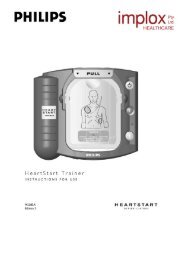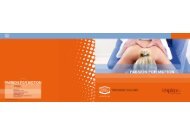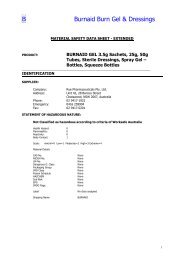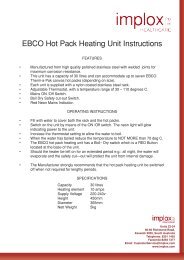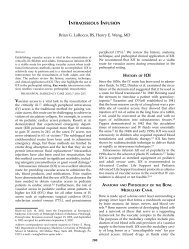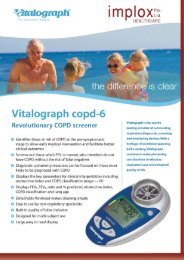Low and medium Frequency Electrotherapy - Implox
Low and medium Frequency Electrotherapy - Implox
Low and medium Frequency Electrotherapy - Implox
You also want an ePaper? Increase the reach of your titles
YUMPU automatically turns print PDFs into web optimized ePapers that Google loves.
5 MUSCLE STRENGTHENING WITH ALTERNATING<br />
CURRENTS<br />
5.1 Introduction<br />
This form of muscle stimulation can only be applied if the peripheral nervous system is intact.<br />
In physiotherapy, the objectives tend to be optimalization of a nonpathological situation, rather than alleviation of a<br />
pathology. An exception is the prevention of atrophy, e.g. in immobilization.<br />
The therapeutic objectives include:<br />
• restoration of the sensation of muscle tension following surgery or trauma;<br />
• increasing the muscle strength to improve the (active) stability of a joint;<br />
• maintaining the condition of a muscle (prevention of atrophy).<br />
Before giving an overview of the various types of alternating current that can be used, we shall first consider some<br />
kinesiological aspects.<br />
5.2 Kinesiological aspects<br />
In physiotherapy it has become usual to refer to tonic <strong>and</strong>/or phasic musculature. It would, in fact, be better to refer to<br />
tonic <strong>and</strong>/or phasic motor units. In general, the classification used is that propsed by J<strong>and</strong>a (8) . J<strong>and</strong>a’s greatest<br />
contribution was to describe the clinical behaviour of the musculature.<br />
However, J<strong>and</strong>a’s classification is not accurate on all points. Posture (antigravity) muscles should be tonic, <strong>and</strong> tend<br />
towards shortening. According to J<strong>and</strong>a’s classification, many typically postural muscles, such as the ascending <strong>and</strong><br />
horizontal parts of the trapezius, belong to the phasic musculature. Furthermore, it has been found in practice that<br />
phasic musculature is also capable of shortening.<br />
From other investigations (9, 14, 15) it appears that the distribution of fibre types in the muscles does not correspond to<br />
J<strong>and</strong>a’s views, <strong>and</strong> that it can vary considerably from one individual to another. Johnson, in particular, showed in an<br />
autopsy study (9) carried out in six men within 24 hours of death that there are marked differences between the<br />
distribution of fibre types in the muscles of different individuals (Table 1).<br />
With one exception, all muscles in the human body are composed of a mixture of fibre types. Thus, there appears to<br />
be a difference between the muscle fibre distribution in a particular muscle <strong>and</strong> its clinical behaviour as described by<br />
J<strong>and</strong>a.<br />
In general it can be stated that, in a movement, the tonic motor units are the first to come into action. The phasic<br />
motor units only become active if additional strength is required (15) . In rapid movements, the phasic motor units may<br />
be activated earlier than the tonic motor units. According to Kluo <strong>and</strong> Clamann (15) , this phenomenon is most marked<br />
in synergistic muscles with different fibre distributions.<br />
Electrical stimulation over a long period can lead to a change in the muscle fibre distribution (6) . The change appears<br />
to be mainly dependent on the frequency with which the motor neuron is depolarized by the electric current. This<br />
effect should be taken into account in lengthy treatments. The change in the muscle fibre distribution is reversible. In<br />
other words, the muscle fibre distribution will adapt the function if the muscle is used.<br />
Tonic motor units<br />
Red muscle fibres<br />
Phylogenetically older<br />
Better vascularization<br />
Innervation by Aa 2 neurons<br />
Tetanic frequency 20-30 Hz<br />
Slowly tiring<br />
Static<br />
Phasic motor units<br />
White muscle fibres<br />
Phylogenetically younger<br />
Poorer vascularization<br />
Innervation by Aa 1 neurons<br />
Tetanic frequency 50-150 Hz<br />
Rapidly tiring<br />
Dynamic<br />
Table 2.<br />
Characteristics of tonic <strong>and</strong> phasic motor units (8) .<br />
28





